
A new State of the Climate report confirms that concentrations of the most dominant greenhouse gases—methane, nitrous oxide, and carbon dioxide (CO2)—reached new record highs in 2021. The gases are the three largest contributors to Earth’s warming, according to the NOAA.
The annual global average CO2 concentration grew at its fifth-highest rate since 1958, the start of the instrumental record. At 414.7 ppm (± 0.1), CO2 reached the highest concentration in the modern record and in records dating back 800,000 years via data derived from ice cores.
Overall, 2021 was marked more by trends that were ameliorated, rather than enhanced, by shorter-term phenomena, most notably the “double dip” La Niña, according to the State of the Climate in 2021, released by the American Meteorological Society (AMS) and led by NCEI.
The 32nd annual issuance of the report is based on contributions from more than 530 scientists from 67 countriesThe 32nd annual issuance of the report is based on contributions from more than 530 scientists from 67 countries around the world and reflects tens of thousands of measurements from multiple independent datasets. Both highlights and the full report are available online.
The 32nd annual issuance of the report is based on contributions from more than 530 scientists from 67 countries

2021 Highlights: State of the Climate
The report’s climate indicators show patterns, changes and trends of the global climate system. Examples of the indicators include various types of greenhouse gases; temperatures throughout the atmosphere, ocean, and land; cloud cover; sea level; ocean salinity; sea ice extent and snow cover.
Report highlights include these indications of a warming planet:
- The dominant greenhouse gases—carbon dioxide, methane, and nitrous oxide—all reached new record highs
- Lake surface temperatures were their highest on record
- Annual global sea surface temperature was lower than 2019 and 2020 due in large part to La Niña, yet still 0.29°C higher than the 1991–2020 average
- Ocean heat content and global sea level rise reached record levels
- Global drought continued in 2021 and peaked at 32% of global land areas in August
530 scientists? Really?! And the results are from only 1958? Apparently, these people have never heard of geologic time, over which it’s obvious that the climate has warmed and cooled, irrespective of the quantity of various gasses. And apparently these 530 scientists aren’t in the following group of just a few more…
https://wattsupwiththat.com/2022/08/26/friday-funny-there-is-no-climate-emergency/